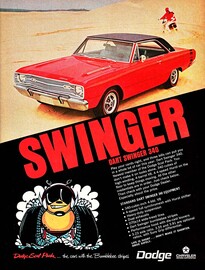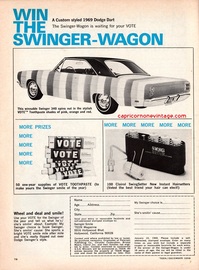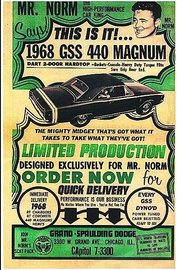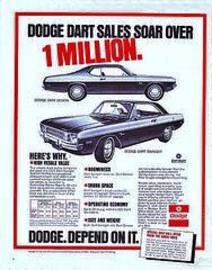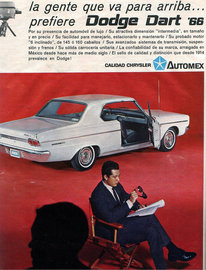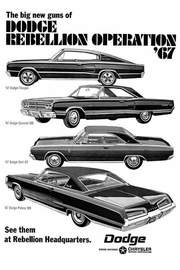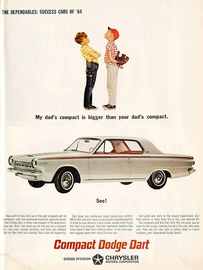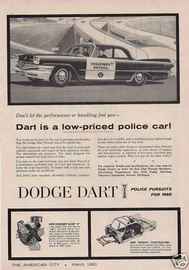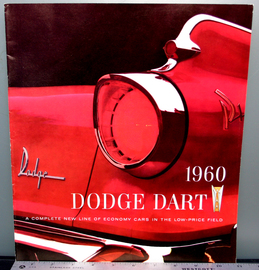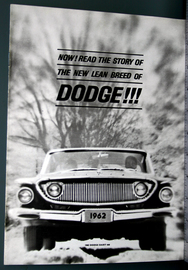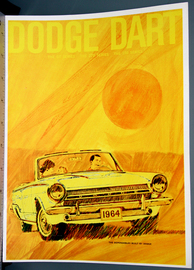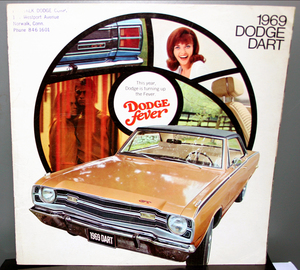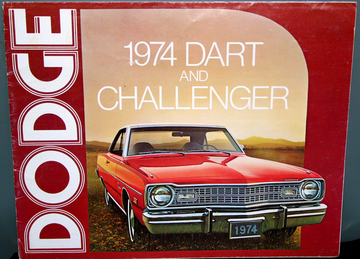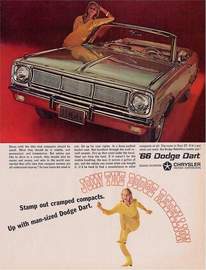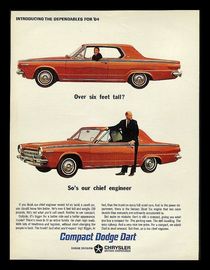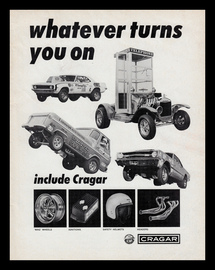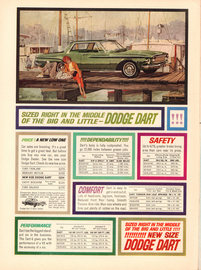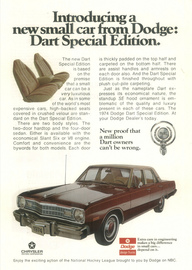Dodge Dart
The original Dodge Dart is an automobile built by Dodge from 1960 to 1976 in North America, with production extended to later years in various other markets. The Dart nameplate was resurrected for a Fiat-derived compact car introduced in 2013.
The Dart name originally appeared on a 1957 show car featuring a body designed by the Italian coachbuilder Carrozzeria Ghia. The production Dart was introduced as a lower-priced, shorter wheelbase, full-size Dodge in 1960 and 1961, became a mid-size car for 1962, and finally was a compact from 1963 to 1976.
The first Dodge Darts were introduced for the 1960 model year. They were downsized large cars developed to replace the Plymouth in the standard, low-priced car segment for the Dodge dealer network. Dodge dealers had been selling Plymouths since 1930, but divisional restructuring took the Plymouth brand away from the Dodge dealer network. Project planners proposed the name Dart, only to have Chrysler executives demand an expensive research program which produced the name Zipp. This was promptly rejected in favor of Dart.
With the cancellation of Chrysler's upper level DeSoto brand, upper level Dodge products were pushed upmarket, while using Plymouth products with more features for lower-level Dodge products. The Dart sedans and coupes were based on the Unibody Plymouth platform with a 118 inch wheelbase, shorter than the standard-size Dodge line. However, the Dart station wagons used the same 122 inch wheelbase as the upmarket Polara wagons. The Dart line was offered in three trim levels: the basic Seneca, mid-range Pioneer, and premium Phoenix. The new Dart came standard with an new engine, the 225 cubic inch Slant-6. The 318 cubic inch (standard equipment on certain Phoenix and Pioneer body styles) and 361 cubic inch V-8s were optional with 2-barrel or 4-barrel carburetors, and with single or dual exhaust. The Dodge 383 cubic inch V-8 was added in 1961. Brakes were 11-inch drums.
Sales of the new Dart were greater than those of the full-size Dodge Matador and Dodge Polara, which also created an in-house competitor for Plymouth. Advertising from 1960 and 1961 compared the Dart to the "c" car (chevrolet), the "F" car (FORD) and the "P" car (Plymouth). After the economic downturn of 1958-59, Dodge production for 1960 rebounded to a 367,804 cars, the division's highest total to date and good for 6th place behind Chevrolet, Ford, Plymouth, Rambler, and Pontiac. Chrysler officials were somewhat less comforted at how 87% of Dodge's volume consisted of the low-profit Dart line, compared to the upmarket Matador and Polara, of which only 41,000 were sold for the 1960 model year.
As Dart sales climbed, Plymouth's sales dropped. Chrysler executives did little to stop the infighting between the divisions. Dart sales were so strong in 1960 that production of the medium-priced model lines were reduced. The full-size, mid-priced Matador was discontinued after the 1960 model year as buyers selected the slightly smaller but better-appointed and less expensive Dart Phoenix. The premium Polara remained in the medium-price segment in 1961.
Virgil Exner's 1961 styling with its reverse fins, rear fender scalloping (the headlights were widely referred to as "ingrown toenails") and concave grille was highly unpopular with consumers. The low position and small size of the Dart's tail lights just above the corners of the bumper, was also criticized and drivers of following cars complained that they could not see them. The wraparound taillights projected light sideward, not rearward. By mid-year, Dodge made auxiliary taillights available at extra cost through its dealer network. However, these large round lights were mounted near the inboard side of the reverse fins, and aggravated the already awkward styling.
For 1962 the Seneca, Pioneer, and Phoenix trim levels were dropped; trim levels became Dart, Dart 330, and Dart 440. The Polara 500, offered in 2-door hardtop, 4-door hardtop, and convertible styles, was dimensionally identical but not officially a Dart by dint of its "Polara 500" badging. The Polara 500 was not built or sold in Canada, and the Dart models were the same as in the U.S. except that the base model was badged Dart 220.
The Dart and Polara were downsized as part of Chrysler's hasty effort to compete with what company leaders thought would be downsized large cars.
The 1962 Dart, like the Plymouth, was on a new lightweight unibody "B" platform, featuring Chrysler's well-received "Torsion-Aire" torsion bar front suspension and asymmetric rear leaf springs. The rigidity gained through the nearly pure unibody platform combined with the suspension's low unsprung weight and near-ideal geometry provided sound handling, braking, and acceleration; the latter especially with the mid-year 415 H.. "Ramcharger" 413 cubic inch V- 8 which was aimed primarily at sanctioned drag racing, where it quickly broke performance records.
The 1963 Dart was an instant market success, with sales up sharply compared to those of the 1962 Lancer. The Dart remained extremely popular through the end of its production run in 1976.
In 1970, Dodge gained a version of Plymouth's popular Valiant-based fastback Duster and was to be named the Beaver, but when Chrysler's marketing department learned that "beaver" was C.B. slang for vagina, the vehicle was renamed the Dart Demon.
As was the case with previous Dodge rebadges of Plymouth Valiants, such as the 1961–1962 Lancer, sales of the Demon lagged behind those of the Duster. With optional hood scoops and blackout hood treatment, the car was advertised a performance car. The Demon's Dart-type front fender wheel lips and Duster-type rear wheel fender lips reveal the car was essentially a Duster with Dart front sheetmetal and other minor styling changes.
The Swinger 340, Dart's performance model, was replaced by the Demon 340 with optional hood scoops and blackout hood treatment. In 1971, Chrysler abandoned their longstanding corporate practice of installing left-hand-threaded wheel studs on the left side of the vehicle; all-wheel studs on the Dart thenceforth used conventional right-hand threads.
In 1973, the Demon fastback was renamed Dart Sport in response to Christian groups' complaints about the 'Demon' name and devil-with-pitchfork logo. The high-performance model thus became Dart Sport 340, and 1973 saw styling changes to go along with the name change. The Dart Sport received the same new front end as the other Darts, and its taillights were changed to two lights per side, each with a chrome trim ring. These would remain unchanged through the 1976 model year.
1976 was the Dart's final year in the North American market. The rear-view mirror was mounted on the windshield rather than from the roof. Front disc brakes became standard equipment on 1 January 1976 in accord with more stringent U.S. Federal brake performance requirements, and a new foot-operated parking brake replaced the under-dash T-handle used since the Dart's 1963 introduction as a compact car. The grille's parking lamps were cast in amber, whereas the previous years had clear lenses with amber-colored bulbs.
The Dart Sport 360 was dropped as a separate model in 1976, but the 360 cubic inch four-barrel, dual exhaust (without catalytic converters) V-8 was a $376 option (except in California) for the $3,370 Dart Sport V8 models with automatic transmission. Car & Driver magazine tested the Dart Sport 360 in the April 1976 issue, and found its top speed of 121.6 M.P.H. to be second.
The A-body Dart was replaced by the F-body Dodge Aspen in late spring of 1976. The compact car segment was expanded with the Omni for Dodge to compete in a rapidly changing automobile market. These were replaced by the smaller front-wheel-drive Aries, as well as several captive import models. Dodge's economy car segment was then filled by the Shadow and the Spirit (unrelated to the AMC Spirit), which themselves were replaced by the Neon. After 35 years, the Dodge Dart (PF) was resurrected or the 2013 model year as a nameplate in the domestic market to replace the Caliber as Dodge's compact passenger car.



